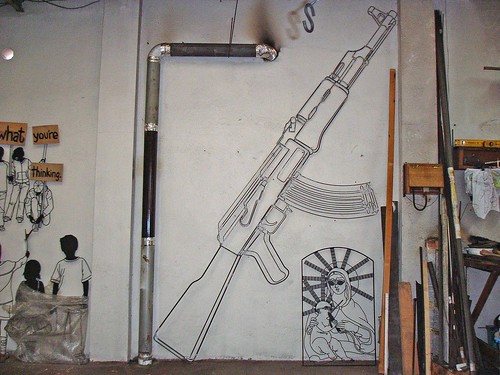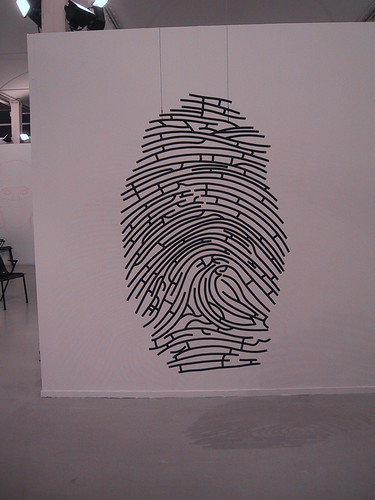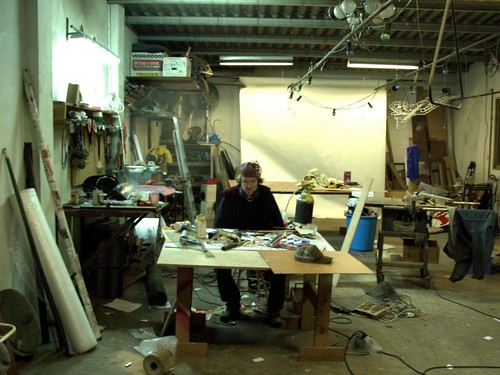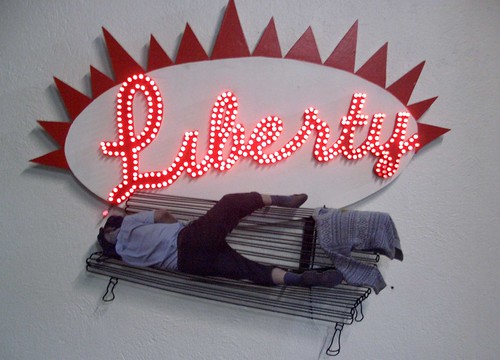 I like things to be accessible; it’s important for me to communicate to the non-art crowd as well as those more versed in art appreciation so I keep the entrance point as accessible as possible and leave it up to the viewer to see how far they want to take their understanding of the piece.
I like things to be accessible; it’s important for me to communicate to the non-art crowd as well as those more versed in art appreciation so I keep the entrance point as accessible as possible and leave it up to the viewer to see how far they want to take their understanding of the piece.
The Rumpus: Why steel?
Frank Plant: My inspiration to work in steel was definitely the film Flashdance. Like so many welders my age the sight of Jennifer Beals welding has had a lasting impact. I also happen to like the permanence of metal and the techniques one uses to manipulate it. For the particular language that I’ve developed it’s ideal; I get clean strong lines and images out of it and the pieces are resilient and novel simultaneously. I also very much enjoy metal in contrast to other materials that I use in pieces with it.
Rumpus: Do you think the material has certain connotations? When I think of steel I think of an industrial, almost American blue collar aesthetic or ethos. Maybe I’m thinking of steel factories and American culture’s relationship to the material.
Frank Plant: For me, steel communicates a lot of things but principally the idea of permanence and strength and, in the manner I am using it, it becomes a simple illustrative vehicle for my ideas. In my application or use of metal I’ve stripped it down and bent it into a somewhat basic graphic visual language.
Rumpus: You’re using steel to create images of modern day leisure items—a corkscrew or boom box or headphones. How does your form relate to the content?
 Frank Plant: Actually most of the pieces that refer to objects are from 2001 to 2004, although I have returned recently to doing some, most recently the giant Kalashnikov titled “Something for Everyone.” That piece refers to the fact that the Kalashnikov, perhaps the most fabricated weapon in the history of weapons, means a lot of different things to a lot of different people. I flocked that piece as well with red rayon fibers which leaves it with a fuzzy inviting surface texture. I did this to show that for a lot of people, certain Africans primarily, it is a symbol that they have a lot of affection for because it is viewed as a tool that helped them escape the shackles of colonialism and/or puppet dictatorships as well as other forms of repression.
Frank Plant: Actually most of the pieces that refer to objects are from 2001 to 2004, although I have returned recently to doing some, most recently the giant Kalashnikov titled “Something for Everyone.” That piece refers to the fact that the Kalashnikov, perhaps the most fabricated weapon in the history of weapons, means a lot of different things to a lot of different people. I flocked that piece as well with red rayon fibers which leaves it with a fuzzy inviting surface texture. I did this to show that for a lot of people, certain Africans primarily, it is a symbol that they have a lot of affection for because it is viewed as a tool that helped them escape the shackles of colonialism and/or puppet dictatorships as well as other forms of repression.
I have certain criteria for selecting the content of the pieces that get made; that ranges from a simple appreciation of the composition of the object . . . to its social and political weight/impact as a symbol.
Rumpus: They seem very straightforward. There’s no inference required on the part of the viewer. Have you always favored this style?
Frank Plant: In a way yes, but I wouldn’t say that there’s no inference involved on the part of the viewer. Sometimes I think most people stay with the superficial, surface aspect of the things they are presented with, . . . myself included. I think it’s natural in today’s world of overwhelming visual cholesterol.
 But a couple cases in point in relation to my own work, “Awkward Moment No. 2,” for example, which I did in collaboration with Thomas Charveriat. (see video here) is an animated sculpture of a woman urinating on the street. Great shock value and we get a lot of really wonderful responses to this piece. But the great thing about that piece is that after the hahas and heehees, and the initial bouts of giggling, the viewer is often left with the more subtle undertones of the awkwardness and vulnerability of the situation at hand which is really what the piece is about. And the responses are often gender based in relation to this piece, more empathy from the woman and a sense of guilty voyeurism from the men, among other things I imagine. . .
But a couple cases in point in relation to my own work, “Awkward Moment No. 2,” for example, which I did in collaboration with Thomas Charveriat. (see video here) is an animated sculpture of a woman urinating on the street. Great shock value and we get a lot of really wonderful responses to this piece. But the great thing about that piece is that after the hahas and heehees, and the initial bouts of giggling, the viewer is often left with the more subtle undertones of the awkwardness and vulnerability of the situation at hand which is really what the piece is about. And the responses are often gender based in relation to this piece, more empathy from the woman and a sense of guilty voyeurism from the men, among other things I imagine. . .
I like things to be accessible; it’s important for me to communicate to the non-art crowd as well as those more versed in art appreciation so I keep the entrance point as accessible as possible and leave it up to the viewer to see how far they want to take their understanding of the piece.
 As for the everyday nature of the pieces and activities in my work it’s a celebration of the quotidian for certain. For me the sublime can be ever present as long as we’re up to the task. The figures I use in my work are (usually) faceless for the reason that the face is the principal source of information we use to deduce a person’s state of being and I feel it can often be misleading. By denying the viewer that traditional source of inquiry and forcing them to digest the body’s more subtle, yet perhaps more honest capacity for communicating, I feel we start to deal with a much more complex and richer vocabulary for expression. It looks simple but actually it’s a universe of factors working in harmony to demonstrate values such as fatigue, humility, fear, rage, vulnerability and a host of others.
As for the everyday nature of the pieces and activities in my work it’s a celebration of the quotidian for certain. For me the sublime can be ever present as long as we’re up to the task. The figures I use in my work are (usually) faceless for the reason that the face is the principal source of information we use to deduce a person’s state of being and I feel it can often be misleading. By denying the viewer that traditional source of inquiry and forcing them to digest the body’s more subtle, yet perhaps more honest capacity for communicating, I feel we start to deal with a much more complex and richer vocabulary for expression. It looks simple but actually it’s a universe of factors working in harmony to demonstrate values such as fatigue, humility, fear, rage, vulnerability and a host of others.
Rumpus: Did you start with sculpting metal or with drawing or some other medium?
Frank Plant: I’ve worked with steel since my second year in college and it’s funny how closely I’ve stuck to some of the original things I developed. Whether that implies that I found my calling early or a lack of capacity for change I don’t know.
Rumpus: How much do you plan out what you’re making before you start? I imagine the process of welding steel has to be very deliberate—unlike painting, in which you can respond to the process as you go along. Is that true or am I totally making this up?
Frank Plant: Sometimes I know from the get-go that the piece will incorporate other materials and other times I decide if something’s needed if I feel it’s not breathing. Sometimes you’re just exploring. Some sculptures are sketches, just like a painter would make and some are more thoroughly thought through. Sometimes it’s really clear and sometimes it’s like groping around in the dark.
Rumpus: What sort of studio setup do you have?
 Frank Plant: I am so lucky with the space that I have; [it is the] first space I saw when I came to Barcelona. (It is a) two-floor, light industrial space where I live/work with my two cats Grappa and Cava. Hotter than hell in the summer and colder than the Arctic in the winter, but overall an ideal space for all my artistic endeavors, large dinner parties, and planning for future world takeover.
Frank Plant: I am so lucky with the space that I have; [it is the] first space I saw when I came to Barcelona. (It is a) two-floor, light industrial space where I live/work with my two cats Grappa and Cava. Hotter than hell in the summer and colder than the Arctic in the winter, but overall an ideal space for all my artistic endeavors, large dinner parties, and planning for future world takeover.
Rumpus: How would characterize the Barcelona “art scene”? What kind of work are artists making there?

Frank Plant: Barcelona art scene is as lame as can be imagined. Lame, lame, lame . . . That is not to say that there are not good artists practicing here, people pushing to develop interesting platforms for culture and a very few galleries that take risks. But for the size of the city that it is and the pride that the Catalans have in themselves for their cultural and intellectual past it is surprisingly sad and flat (I’ll probably never show here again). There is absolutely no reason why Barcelona shouldn’t be competing with the likes of other European cities like Berlin, London, Madrid, or Paris for the mantle of Euro art supremacy, but they just aren’t. Perhaps it’s cyclical. That might not go down well with a lot of people, but Barcelona loses a lot of local artists, producers, and creative minds that move on looking for greener pastures and in hopes of coming back through the big door because of the lack of opportunity here. I don’t know what the factors are and mind you this is but one point of view but it’s all a bit grim. I realize at the root of all these problems there is an economic reality but shit I thought creativity conquered all. Having said all that it does keep you lean and hungry being here; it’s not like I’m sitting around waiting for the next government subsidy (That was a gratuitous shot at all my northern European buddies). In addition the climate is super agreeable, good food and a decent quality of life.
Rumpus: By identifying yourself as an American Barcelona-based artist, you get to live in both worlds. What kind of freedom does this allow you, as an artist?
Frank Plant: I do that as a quantifier, I’m definitely a Yank, no two ways about it but one that has gone through 16 years of socialist brainwashing. It’s just to say I’m an American with some Euro-sensibilities. I like my %&*#ing healthcare as well for all you nitwits who eat what talk radio has been feeding you. There’s gotta be a piece about healthcare in the pipeline…
See and hear more from Frank Plant on his blog.




